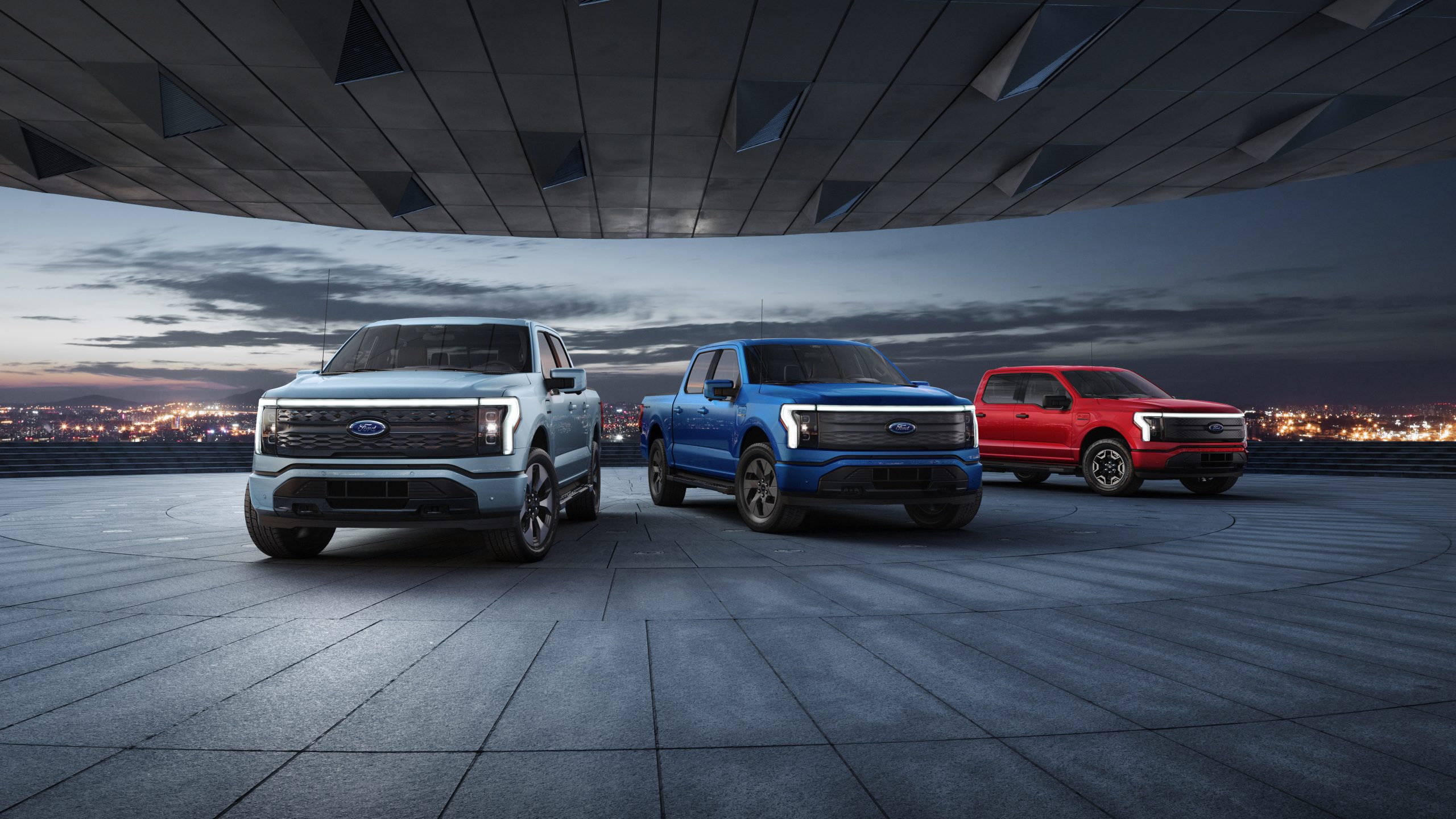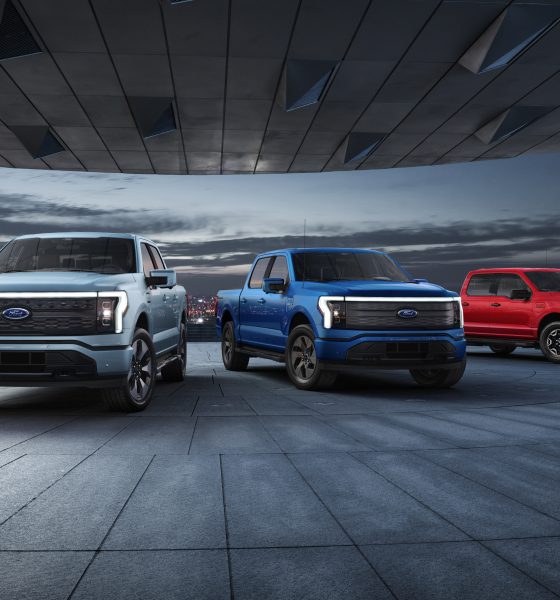

News
Ford bumps its EV investment to $30B, F-150 Lightning grabs 70k pre-orders
Ford has announced that it will boost its electric vehicle investment to $30 billion, up from its previous figure of $22 billion, the company said on Wednesday. Ford is anticipating at least 40% of its vehicle production lines to be manufacturing electric cars by the end of the decade, and the F-150 Lightning, the EV version of its best-selling pickup has accumulated 70,000 preorders just a week after its unveiling event.
Ford now intends to spend at least $30 billion on electric car development by the end of 2025, increasing its spending figure by $8 billion. CEO Jim Farley said that EVs could usher in a new era of growth for Ford and that it’s “our biggest opportunity for growth and value creation since Henry Ford started to scale the Model T.”
Ford also announced that it had picked up a total of 70,000 reservations for the all-electric F-150 Lightning. Just two days after the event, Jim Farley had announced that preorders had reached 44,500, and received a congratulations from Tesla CEO Elon Musk.
Ford F-150 Lightning unveiled: Price, Release date, Range, Features and more
Now making it clear that electrification is its clear-cut focus moving forward, Ford’s bump in its EV investment plan will bring new opportunities to the legacy automaker for long-term growth as EVs begin to gain momentum in auto markets across the globe. After beginning deliveries of the all-electric Mustang Mach-E, a crossover that carries the name of Ford’s legendary muscle car, Ford has plans to produce the F-150 Lightning starting next year in a string of variants that will offer all buyers something specific for their taste. Past the passenger market, Ford also electrified its popular Transit van, simply calling it the E-Transit. Ford’s focus for electrifying its fleet and contributing to a healthier environmental relationship with its vehicles goes past passenger vehicles, as businesses and entities who choose to go with the popular light-cargo van will also utilize Ford’s electric architecture for business needs.
Ford evidently has the support of President Joe Biden as well, who spoke at the company’s Dearborn, Michigan, plant last week in support of the company’s transition to electrification. Biden, who labeled himself as a “car guy” at the beginning of his speech, had the opportunity to ride in the F-150 Lightning as well, who was impressed by the performance and speed of Ford’s introductory electric pickup that will compete with the Tesla Cybertruck, Rivian R1T, and GMC Hummer EV.
Supporting the company’s expansion to electrification, Ford also formed a joint venture with South Korean company SK Innovation last week. The companies venture, called BlueOvalSK, will give Ford the ability to manufacture battery cells at two U.S.-based plants for Ford and Lincoln vehicles.
Ford stock was up over 6% at 12:30 PM in New York, trading at $13.61.
Disclosure: Joey Klender is a TSLA Shareholder, he does not own any Ford stock and has no intentions to initiate any positions within 72 hours.
What do you think? Let us know in the comments below, or be sure to email me at joey@teslarati.com or on Twitter @KlenderJoey.

News
Tesla starts showing how FSD will change lives in Europe
Local officials tested the system on narrow country roads and were impressed by FSD’s smooth, human-like driving, with some calling the service a game-changer for everyday life in areas that are far from urban centers.

Tesla has launched Europe’s first public shuttle service using Full Self-Driving (Supervised) in the rural Eifelkreis Bitburg-Prüm region of Germany, demonstrating how the technology can restore independence and mobility for people who struggle with limited transport options.
Local officials tested the system on narrow country roads and were impressed by FSD’s smooth, human-like driving, with some calling the service a game-changer for everyday life in areas that are far from urban centers.
Officials see real impact on rural residents
Arzfeld Mayor Johannes Kuhl and District Administrator Andreas Kruppert personally tested the Tesla shuttle service. This allowed them to see just how well FSD navigated winding lanes and rural roads confidently. Kruppert said, “Autonomous driving sounds like science fiction to many, but we simply see here that it works totally well in rural regions too.” Kuhl, for his part, also noted that FSD “feels like a very experienced driver.”
The pilot complements the area’s “Citizen Bus” program, which provides on-demand rides for elderly residents who can no longer drive themselves. Tesla Europe shared a video of a demonstration of the service, highlighting how FSD gives people their freedom back, even in places where public transport is not as prevalent.
What the Ministry for Economic Affairs and Transport says
Rhineland-Palatinate’s Minister Daniela Schmitt supported the project, praising the collaboration that made this “first of its kind in Europe” possible. As per the ministry, the rural rollout for the service shows FSD’s potential beyond major cities, and it delivers tangible benefits like grocery runs, doctor visits, and social connections for isolated residents.
“Reliable and flexible mobility is especially vital in rural areas. With the launch of a shuttle service using self-driving vehicles (FSD supervised) by Tesla in the Eifelkreis Bitburg-Prüm, an innovative pilot project is now getting underway that complements local community bus services. It is the first project of its kind in Europe.
“The result is a real gain for rural mobility: greater accessibility, more flexibility and tangible benefits for everyday life. A strong signal for innovation, cooperation and future-oriented mobility beyond urban centers,” the ministry wrote in a LinkedIn post.
News
Tesla China quietly posts Robotaxi-related job listing
Tesla China is currently seeking a Low Voltage Electrical Engineer to work on circuit board design for the company’s autonomous vehicles.

Tesla has posted a new job listing in Shanghai explicitly tied to its Robotaxi program, fueling speculation that the company is preparing to launch its dedicated autonomous ride-hailing service in China.
As noted in the listing, Tesla China is currently seeking a Low Voltage Electrical Engineer to work on circuit board design for the company’s autonomous vehicles.
Robotaxi-specific role
The listing, which was shared on social media platform X by industry watcher @tslaming, suggested that Tesla China is looking to fill the role urgently. The job listing itself specifically mentions that the person hired for the role will be working on the Low Voltage Hardware team, which would design the circuit boards that would serve as the nervous system of the Robotaxi.
Key tasks for the role, as indicated in the job listing, include collaboration with PCB layout, firmware, mechanical, program management, and validation teams, among other responsibilities. The role is based in Shanghai.
China Robotaxi launch
China represents a massive potential market for robotaxis, with its dense urban centers and supportive policies in select cities. Tesla has limited permission to roll out FSD in the country, though despite this, its vehicles have been hailed as among the best in the market when it comes to autonomous features. So far, at least, it appears that China supports Tesla’s FSD and Robotaxi rollout.
This was hinted at in November, when Tesla brought the Cybercab to the 8th China International Import Expo (CIIE) in Shanghai, marking the first time that the autonomous two-seater was brought to the Asia-Pacific region. The vehicle, despite not having a release date in China, received a significant amount of interest among the event’s attendees.
Elon Musk
Elon Musk and Tesla AI Director share insights after empty driver seat Robotaxi rides
The executives’ unoccupied tests hint at the rapid progress of Tesla’s unsupervised Robotaxi efforts.

Tesla CEO Elon Musk and AI Director Ashok Elluswamy celebrated Christmas Eve by sharing personal experiences with Robotaxi vehicles that had no safety monitor or occupant in the driver’s seat. Musk described the system’s “perfect driving” around Austin, while Elluswamy posted video from the back seat, calling it “an amazing experience.”
The executives’ unoccupied tests hint at the rapid progress of Tesla’s unsupervised Robotaxi efforts.
Elon and Ashok’s firsthand Robotaxi insights
Prior to Musk and the Tesla AI Director’s posts, sightings of unmanned Teslas navigating public roads were widely shared on social media. One such vehicle was spotted in Austin, Texas, which Elon Musk acknowleged by stating that “Testing is underway with no occupants in the car.”
Based on his Christmas Eve post, Musk seemed to have tested an unmanned Tesla himself. “A Tesla with no safety monitor in the car and me sitting in the passenger seat took me all around Austin on Sunday with perfect driving,” Musk wrote in his post.
Elluswamy responded with a 2-minute video showing himself in the rear of an unmanned Tesla. The video featured the vehicle’s empty front seats, as well as its smooth handling through real-world traffic. He captioned his video with the words, “It’s an amazing experience!”
Towards Unsupervised operations
During an xAI Hackathon earlier this month, Elon Musk mentioned that Tesla owed be removing Safety Monitors from its Robotaxis in Austin in just three weeks. “Unsupervised is pretty much solved at this point. So there will be Tesla Robotaxis operating in Austin with no one in them. Not even anyone in the passenger seat in about three weeks,” he said. Musk echoed similar estimates at the 2025 Annual Shareholder Meeting and the Q3 2025 earnings call.
Considering the insights that were posted Musk and Elluswamy, it does appear that Tesla is working hard towards operating its Robotaxis with no safety monitors. This is quite impressive considering that the service was launched just earlier this year.








